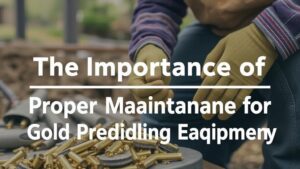How Silver Was Mined in the Cobalt District of Ontario, Canada
Introduction
The Cobalt District of Ontario, Canada, is a historically significant region known for its rich deposits of silver. This article explores the methods and evolution of silver mining in this area, highlighting the key processes, challenges, and technological advancements that have shaped its mining practices.
Historical Background
Silver mining in the Cobalt District began in the late 19th century, particularly after the discovery of silver deposits in 1903. The establishment of the Canadian Cobalt Mines and subsequent mining companies marked the areas transformation into a major source of silver in North America.
The Silver Boom
The Cobalt silver boom occurred from 1903 to 1920, attracting thousands of prospectors and investors eager to capitalize on the vast silver resources. By 1906, the district produced approximately 18 million ounces of silver, contributing to Canada becoming the worlds leading silver supplier during the early 20th century.
Mining Techniques
Mining techniques have evolved over the years, adapting to the unique geological conditions of the Cobalt District.
Hard Rock Mining
The most prevalent method of silver extraction in the Cobalt District was hard rock mining. Miners generally used the following processes:
- Access Tunneling: Miners began by tunneling into the ground to reach the rich silver veins located deep underground.
- Drilling and Blasting: Once the veins were accessed, miners used drilling equipment to bore holes into the rock, followed by explosives to break apart the ore.
- Ore Extraction: Broken ore was then collected and transported to the surface for processing.
Surface Mining
In some cases, surface mining techniques were employed, particularly where ore was located near the surface. This involved:
- Open-Pit Mining: Large pits were excavated to access lower-grade ores, allowing for more extensive surface extraction.
- Heap Leaching: A process of extracting silver from ores by piling broken rock and applying chemicals to leach out the silver.
Extraction Process
The extraction of silver from ore in Cobalt involved a series of steps that included milling, concentration, and smelting. Each stage was crucial for maximizing silver yield.
Milling
The first step after mining was milling, where ore was crushed and ground into a fine powder. This process increased the surface area of the ore, making it easier for chemicals to extract silver.
Concentration
Next, the milled ore underwent concentration, often using flotation methods to separate valuable minerals from waste material. Flotation involved adding reagents that induced the silver-containing minerals to attach to air bubbles and rise to the surface, facilitating removal.
Smelting
After concentration, the remaining silver-rich concentrate was smelted at high temperatures with flux, such as borax or soda ash, to separate silver and other metals. This resulted in pure silver that could be cast into ingots for sale.
Environmental and Economic Impacts
The environmental consequences of mining practices in the Cobalt District have raised concerns over the years. Key issues have included:
- Land Degradation: Mining operations led to the destruction of vast areas of land and ecosystems.
- Water Contamination: Heavy metals from mining activities have compromised local water sources, affecting wildlife and communities.
Economically, however, silver mining has been a boon for the region. At its peak, Cobalts mining industry supported thousands of jobs and stimulated the local economy. Today, the area remains a point of interest for both mining enterprises and historical tourism.
Modern Developments
Recently, renewed interest in the Cobalt District has emerged due to increasing silver prices and advances in mining technology. Modern techniques include:
- Data Analytics: Employing sophisticated data analysis to locate silver deposits more efficiently.
- Environmentally Friendly Practices: Adoption of practices that minimize environmental impact, such as reduced land disturbance and advanced waste management.
Conclusion
Silver mining in the Cobalt District of Ontario has a rich history characterized by innovation and resilience. While the initial boom contributed significantly to regional economic development, ongoing mining practices now focus more on sustainability and technological enhancement. Understanding these historical and modern practices gives insight into both the legacy and the future of silver mining in Canada.



